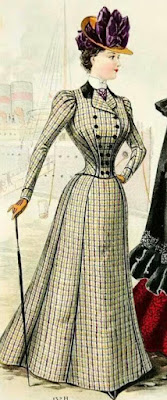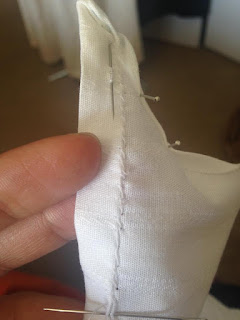Journey to Judge: Researching Ona Judge Part II
It has been a wonderful and yet busy last few weeks for me. From the 11th-13th I spent a few days in Colonial Williamsburg doing research on behalf of the Historic Londontown & Gardens museum in Edgewater Maryland, on how to best implement African American Interpretation into their regular programming.
As soon as I arrived, I immediately hit the streets of Duke of Gloucester in search for answers. I was given lots of helpful advice from the museum educators, Nation Builders, and actor interpreters. I was even given opportunity to shadow one of nation builders to get an idea of how to best talk about slavery (which in itself is a very difficult subject), by showing me how he spoke with groups of visitors who were coming into the Raleigh Tavern; he'd introduced himself as "Benjamin" for each group of people that came in, and start off with an ice breaker about what their favorite type of drink was, then he'd flip it around and say that due to the lack of inventory in the bar, there was no medera or alcoholic libations and the owner and his man were out to get the shipment, but ...
After watching for at least an hour, I learned that during the 18th century there was a total of 17 slaves who worked in the tavern, and Jupiter would take care of the luggage, Polly was in the kitchen cooking, and Sarah was upstairs making the beds for the night. This was to give an example of a working tavern during that time-but letting the audience know that all of this was done mostly by slave labor. Then the next group of visitors would come in and he'd change the tone again, but kept the same story. Surprisingly, this was the most important advice that I managed to take away from this trip.
When I had some downtime. I did a little shopping for things to add to my reenacting kit. But what caught my attention the most were the really great reading materials at the College of William & Mary's bookstore on slavery in the 18th century. The Book called The Slave Ship: A Human History, by Marcus Redkier grabbed my attention and even though I have not read it yet, I knew it would be a good addition to my library and a pivotal part of the importance of teaching about the middle passage.
As soon as I arrived, I immediately hit the streets of Duke of Gloucester in search for answers. I was given lots of helpful advice from the museum educators, Nation Builders, and actor interpreters. I was even given opportunity to shadow one of nation builders to get an idea of how to best talk about slavery (which in itself is a very difficult subject), by showing me how he spoke with groups of visitors who were coming into the Raleigh Tavern; he'd introduced himself as "Benjamin" for each group of people that came in, and start off with an ice breaker about what their favorite type of drink was, then he'd flip it around and say that due to the lack of inventory in the bar, there was no medera or alcoholic libations and the owner and his man were out to get the shipment, but ...
After watching for at least an hour, I learned that during the 18th century there was a total of 17 slaves who worked in the tavern, and Jupiter would take care of the luggage, Polly was in the kitchen cooking, and Sarah was upstairs making the beds for the night. This was to give an example of a working tavern during that time-but letting the audience know that all of this was done mostly by slave labor. Then the next group of visitors would come in and he'd change the tone again, but kept the same story. Surprisingly, this was the most important advice that I managed to take away from this trip.
After my research papers were sent over to the museum, I then focused on my continued research and development for my interpretation as Ona Judge in September (for the same museum). I had the wonderful opportunity to work with the Nation Builders who portrayed George & Martha Washington, and Aggy (Who also portrayed Ona Judge for CW's Hero Live! school documentary). I also had the honor of working with the new Martha Washington at Mount Vernon. So needless to say, all of my bases were covered.
As I talked with each of them, I learned to look at the facts from a different perspective. We touched base on the relationship between Martha and Ona Judge (was it more maternal, or just master/servant? Both?). Another important factor was the Washington's stance on Slavery, The Fugitive Slave Act of 1793 that Washington wrote into Law, and the many reasons that played a part of Ona finally deciding to run away, and why to New Hampshire of all places.
While these may sound like simple questions that have simple answers, there were points that I felt needed to be explored from every angle; especially if I were telling them from Ona's perspective. Afterwards, I got started on writing my script (which is still in progress) and used not only the advice given to me by the Nation Builders, but also used my own experience of being a runaway slave back in January when Historic London Town had their Immersion weekend. How anxious and fearful Ona must have felt when she slipped away to her liberty, knowing very well that she was now a fugitive and could be captured and sent back to her masters or sold to the West Indies. I intended to use the same fear I felt with that performance and implement that into this one.
On Saturday, I was back home in Maryland where I volunteered my time at the B&O Railroad Station Museum in Ellicott City. When I was in highschool, I used to work there on the weekends (which coincidentally was my starting point to wanting to have a career in Museum Education). Anyway, the museum was having a very important event called "Men of Color, To Arms": Recruiting African-Americans During The Civil War. It was a very educational event and had at least 400 visitors show up to learn about a less talked about aspect of the American Civil War. I had the opportunity to talk with these fine gentlemen, and even ask them about the best ways to implement African-American Interpretation, not only for the museum but also for my own interests. The more we all talked, the more I learned from their experiences and was even asked to join the Black Phalanx Brigade: Afro-Malitaria Consultants and Reenactors' Guild, which teaches about African-Americans in military history, and The Sons & Daughters of Ham, a unit dedicated to talking about the African-American experience post Civil War. Very honored to be inducted into both guilds, and with that I hope to learn more and to teach more.
On Saturday, I was back home in Maryland where I volunteered my time at the B&O Railroad Station Museum in Ellicott City. When I was in highschool, I used to work there on the weekends (which coincidentally was my starting point to wanting to have a career in Museum Education). Anyway, the museum was having a very important event called "Men of Color, To Arms": Recruiting African-Americans During The Civil War. It was a very educational event and had at least 400 visitors show up to learn about a less talked about aspect of the American Civil War. I had the opportunity to talk with these fine gentlemen, and even ask them about the best ways to implement African-American Interpretation, not only for the museum but also for my own interests. The more we all talked, the more I learned from their experiences and was even asked to join the Black Phalanx Brigade: Afro-Malitaria Consultants and Reenactors' Guild, which teaches about African-Americans in military history, and The Sons & Daughters of Ham, a unit dedicated to talking about the African-American experience post Civil War. Very honored to be inducted into both guilds, and with that I hope to learn more and to teach more.
Well, that's it for now. Time to get back to researching and sewing.





.jpg)


Comments
Post a Comment